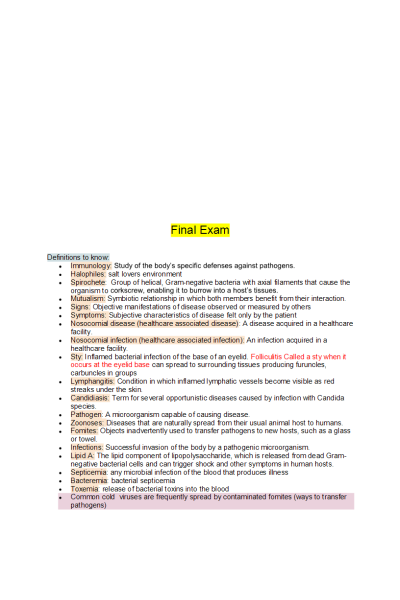BIOS 242 Week 8 Final Exam (Study Guide)
-
$35.00
| Institution | BIOS 242 Fundamentals of Microbiology with Lab |
| Contributor | elizabeth Oslen |
FINAL EXAM STUDY GUIDE – MICRO MARCH 2018
INSTRUCTIONS:
It’s time to show your skills and knowledge of what you have learned!
This Final Exam contributes 230 points to your overall grade, so please do your best.
- There are 60 multiple choice questions worth 3 points each (180 total points).
- There are 5 Fill in the blanks question worth 3 points each (15 total points).
- There are 5 “Select all that apply” question worth 3 points each (15 total points).
- There is 1 matching question worth 5 points (5 total points).
- There is 1 essay question worth 5 points (5 total points).
- There is 1 essay questions worth 10 points (10 total points).
TCO 1: Given a list of Koch's postulates, analyze how early microbiologists proposed hypotheses and performed experiments to determine the causes of various diseases.
- Describe the contributions of Leeuwenhoek and Koch to the field of microbiology.
- Describe the six different categories in which the organisms described by Leeuwenhoek were grouped.
TCO 2 – Given pictures of a variety of microorganisms including fungi, protozoa, bacteria, and viruses, classify each as prokaryotic, eukaryotic, or acellular and compare and contrast their structure and function.
- Describe cellular macromolecules such as carbohydrates, lipids, proteins, and nucleic acids, and the roles they play in cellular structures (Ch. 2)
- Compare and contrast molecular components of prokaryotes (Bacteria and Archaea), eukaryotes, and viruses as well as the environmental conditions these can be found in
- A Classify and describe the general characteristics of prokaryotes.
- Describe Gram positive, Gram negative, and Acid Fast cell wall/membrane structures including molecular components (lipids, acids, endotoxins, periplasmic space).
- Compare/contrast methods of transport into and out of cells
- Compare/contrast archaea and bacteria in terms of cellular structures and how they were separated by Carl Woese.
- Compare/contrast prokaryotes and eukaryotes in terms of size, shape, reproduction, motility, organelles, metabolic processes
TCO 3 – Given several types of microscopes, evaluate how scientists use the microscopes to identify and study microorganisms.
- Describe the principles of various types of microscopy and their applications.
- Describe various staining methods used in microscopy
- Analyze the different methods of classification and identification of microorganisms.
TCO 4 – Given a culture of a microorganism, examine its physical and nutritional requirements.
- Explain how environmental conditions (temperature, pH, oxygen, and osmotic and hydrostatic pressure) affect microbial growth.
- Describe the information that can be interpreted from a growth curve; name the four phases and know what makes each unique
TCO 5 – Given a nutritional requirements of a microorganism, analyze the processes of microbial metabolism
- Compare and contrast respiration and fermentation.
- Discuss the macromolecular structure as well as function of enzymes in a cell
- Describe the three stages of aerobic glucose catabolism.
- Compare aerobic and anaerobic metabolism in terms of products and # ATP produced
TCO 6 – Given the characteristics of a eukaryotic organism, classify it into its right kingdom based on genetic relatedness.
- Describe the characteristics of protozoa, their nutritional requirements, and their mode of reproduction, and relevant vocab (structural features).
- Describe the characteristics of fungi that distinguish them from other eukaryotes.
- Discuss the role of arthropod vectors in disease transmission; differentiate mechanical and biological vectors
TCO 7 – Given the characteristics of an acellular pathogen, identify the pathogen to design the appropriate treatment strategy.
- Discuss the classification strategies of a virus.
- Describe the intracellular and extracellular structures of viruses
- Discuss the various modes of replication of a bacteria virus and animal virus.
- Discuss the different ways viruses can be cultured in a lab.
- Compare and contrast viruses, virions, prions, and viroids.
TCO 8 –Analyze methods of controlling microbial growth in the environment and in the body.
- Describe the appropriate physical and/or chemical methods of controlling microbial growth when given a particular scenario (e.g. sterilizing insulin, saline solution, fresh fruits/veggies, goggles; de-germing local injection site, table tops, etc.)
- Summarize the mode of action of major groups of antimicrobial and antiviral drugs.
- Summarize practices that have led to increased bacterial antibiotic resistance and strategize ways to limit this increased resistance.
- Describe factors to be taken into account when selecting antimicrobial and antiviral drugs, including drug effects on patients.
TCO 9 – Given an illustration of the three lines of defense that protect the human body from pathogens, analyze how the components of each work to prevent or overcome infection
- Differentiate between the five different classes of antibodies.
- Differentiate between passive and active acquired immunity.
TCO 10 –Given data on an outbreak of a microbial disease, propose a plan that outlines the steps taken to identify the cause of the disease and to stop or limit the spread of the infection.
TCO 11 – Given a patient with the symptoms of influenza or another infectious disease, identify the causative agent and analyze its pathogenicity.
MICROBES TO KNOW: (unique features, associated diseases, targets for antimicrobials)
DISEASES TO KNOW: (causes, symptoms, signs, prevention)
| Instituition / Term | |
| Term | Summer 2021 |
| Institution | BIOS 242 Fundamentals of Microbiology with Lab |
| Contributor | elizabeth Oslen |





























